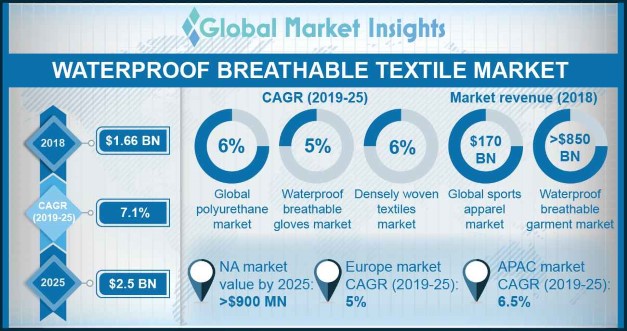Home > Chemicals & Materials > Textiles > Functional Textiles > Waterproof Breathable Textiles (WBT) Market
Waterproof Breathable Textiles (WBT) Market Size
- Report ID: GMI134
- Published Date: Aug 2019
- Report Format: PDF
Waterproof Breathable Textiles Market Size
Waterproof Breathable Textiles Market size was over USD 1.6 billion in 2018 and industry expects consumption at over 700 million square meters by 2025.

Growing consumer preference towards light wear, comfortable clothing along with increasing penetration of high-performance fabric in sportswear industry shall foster the waterproof breathable textiles market growth. Increasing popularity among consumers toward comfortable clothing during intense workouts and training sessions has augmented high-performance apparels demand. Global sports apparel market revenue amounted over USD 170 billion in 2018 which shows significant opportunities for market growth. Increasing awareness about the benefits of waterproof breathable textiles in extreme weather conditions and growing demand for multifunctional fabric from various industries shall further boost the market growth
Waterproof breathable textiles offer superior protection against various external factors such as wind and rain. Europe industrial protective clothing market valued over USD 1.6 billion in 2018. The fabric is widely used in the production of waterproof jackets, footwear, bottoms and gloves as they enhance the comfort level by eliminating the moisture buildup in the fabric which is the major driving factor of the market. These products support maximum wear comfort and offer a wider functionality as compared to traditional outdoor clothing. Increasing technological advancements in textile manufacturing and growing demand for comfortable fabrics in the apparel & footwear industry shall further propel the waterproof breathable textiles market share.
| Report Attribute | Details |
|---|---|
| Base Year: | 2018 |
| WBT Market Size in 2018: | 1.6 Billion (USD) |
| Forecast Period: | 2019 to 2025 |
| 2025 Value Projection: | 2.5 Billion (USD) |
| Historical Data for: | 2014 to 2018 |
| No. of Pages: | 585 |
| Tables, Charts & Figures: | 812 |
| Segments covered: | Textile, Raw Material, Product and Region |
| Growth Drivers: |
|
| Pitfalls & Challenges: |
|
Changing consumer lifestyle and fashion trends pertaining to increasing penetration through various digital platforms has created several opportunities for new fashion & lifestyle trends which might hinder the market growth. In addition, technological advancements have made it possible to incorporate smart fabric in textiles which offer temperature equalization and weather control. The technology prevents leakage during liquid phase, provide superior thermal insulation and protection against wind and rain which may hamper the market growth. However, increasing consumer preference towards environmentally friendly products along with demand for sportswear that offers resistance to bacteria and reduces odor may preferably accelerate the product demand.
